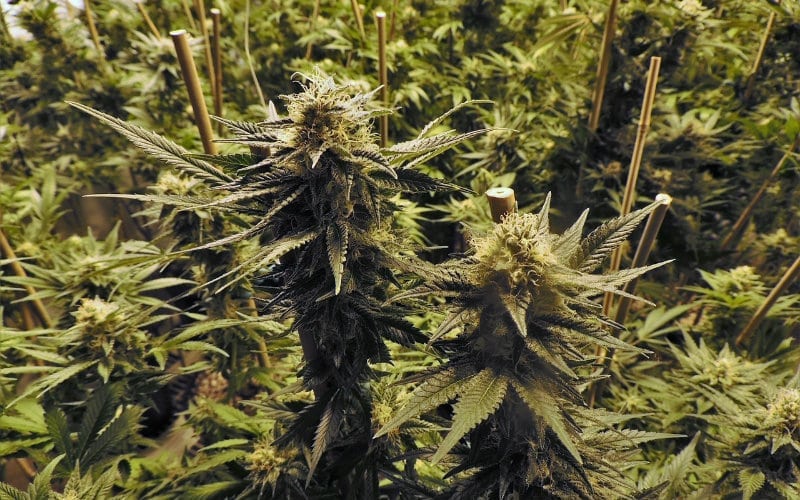A commercial grow room is a designated area in which plants are germinated, grown, and ultimately brought to flower. There are a few key components to consider when designing a efficient and sustainable commercial grow room, such as how much space is required, how to water crops, how to provide power, and how to properly light the space.
Choosing a Space for Your Commercial Grow Room
When designing a grow room, the first consideration is where to house your operation. The most efficient option is a greenhouse. According to the Southwest Energy Efficiency Project (SWEEP), “Greenhouse grow operations typically save 60-75 percent of the energy needed per pound of flower compared to indoor grow facilities.”
Whether using a greenhouse or operating an indoor grow, consider how many plants will occupy the space and what breed of plant will be grown. Some varieties grow short and broad, whereas others grow tall and thin. These variations will also dictate how much space to leave between the plant and the light source you are using.
Choosing a discreet location will help ensure the security of your harvest. Cannabis cultivation is an investment with high returns and people may seek to take advantage of your hard work for their own gain. As such, theft-awareness and security should always be a consideration when choosing an ideal location.
Further, choose a space with lots of options for customization. Lighting, watering, and ventilation must all be easily controlled and regulated to maximize yields. A naturally well-ventilated space is ideal, but installing commercial grade ventilation will ensure good airflow. A well-insulated space will also increase energy efficiency and lower costs.
Using Living or Organic Soil and Nutrients
When possible, sustainable growing operations will utilize living soil and organic nutrients. Living soil is rich in microorganisms and microfauna, which break down nutrients in the soil and make them easier for the plant to absorb.
Organic soils and nutrients are not only sustainable, plants grown with these techniques tend to have more robust taste and flavor profiles than buds grown using non-organic methods.
Most indoor operations grow their crops hydroponically. Hydroponic “soils” are often blends with a coco, peat, or sphagnum base. Using organic or sustainably sourced hydroponic mediums will decrease your environmental impact.
Best Watering Practices for a Sustainable Commercial Grow Operation
There are several watering options available to the commercial grower. Hydroponic growing is widely considered the most efficient and sustainable growing method for indoor operations for several reasons.
First, a hydroponic system reduces the need for pesticides and herbicides. Second, hydroponically grown plants grow faster and can reduce water consumption by up to 90 percent as opposed to traditional agricultural methods. Further, plants grown hydroponically in urban environments are typically closer to their final destination, resulting in lower transportation costs and a smaller carbon footprint.
Some of the most popular alternative methods for indoor watering are hand watering, drip irrigation, and flood tables. Drip irrigation and flood tables are the most efficient options as both processes are automated, resulting in less waste and more consistent yields. Both options are ideal for grows larger than 2,500 square feet.
According to the Denver Department of Public Health & Environment (DDPHE), automating the watering process also allows for increased real-time daily data collection. This data enables growers to to measure their water use during each phase of growth and track runoff percentages.
Runoff is excess water that is not absorbed by the plant. The DDPHE defines 10 to 15 percent runoff per watering event as an efficient and attainable target for commercial growing operations. Further, the DDPHE’s Cannabis Environmental Best Management Practices Guide advises growers: “Ongoing measurement against this target will help maintain overall water efficiency and identify factors that affect water use, such as employee turnover, schedule changes, and equipment changes.”
Water recycling is another important component of sustainable commercial indoor grow operations. Runoff and vapor are the two primary sources of recyclable water. Both must be sterilized prior to reuse, typically with technologies that kill waterborne pathogens. UV water filtration, copper water treatment, and electrochemically activated water are all good options for purification.
Choosing an Efficient HVAC for a Commercial Grow Room
Ventilation, cooling, and dehumidification are energy intensive components of any commercial grow operation. Smaller grows often use ductless mini-split air conditioners because of their small size, energy efficiency, and versatility for heating or cooling individual rooms. Larger grow operations can save up to 40 percent of their power by using chilled water systems for dehumidification and cooling as opposed to traditional HVAC systems.
Sustainable Lighting Options and Costs
There are a variety of lighting options available for indoor grow operations. Each stage of the plant’s development may respond better to different light sources. For example, clones, seedlings, and young plants tend to respond well to fluorescent lighting. Conversely, fluorescent lighting can inhibit growth if used during the flowering stage of development.
Overall, the most energy-efficient lighting for grow room operations at any stage is LED. According to SWEEP, vegetative rooms can save up to 50 percent on lighting energy by utilizing LED. They last longer, run cooler, and use far less power than traditional methods. However, without adequate space between the LED and the plant, light burning can occur and inhibit yield.
The most important aspect of sustainable production is setting targets for optimal growth with minimum input. According to the DDPHE, “The correct measurement for obtaining best results is PPFD, or the number of photons of PAR that are hitting the top of the canopy … The more useable photons consistently hitting the crop, the quicker it will grow.”
Thoughtful lighting design as well as adjustable light fixtures will increase the efficiency and productivity of your grow. The initial costs associated with lighting may seem like a large investment, but they are only a small fraction of the overall cost of your lighting choices. Operating costs, product lifespan, maintenance costs, and disposal costs should all be calculated prior to installation.
Waste Disposal Solutions for Your Grow Room
The cannabis cultivation process results in an inordinate amount of organic waste. Proper composting is essential to operating a sustainable grow, though it may present some logistical and compliance challenges. Two of the most sustainable options are Bokashi fermentation and traditional composting.
Bokashi Fermentation is typically an on site treatment option. The waste must be ground and stored in an air-tight container and blended with Bokashi, or another compost activator, and water. After a two-week anaerobic fermentation period, the waste will transform into a nutrient-rich liquid fertilizer.
Plant waste, paper, and food waste doesn’t have to end up in the landfill. A licensed hauler can transport relevant materials to a commercial composting facility once it is ground into an “unusable and unrecognizable” form of cannabis debris. Separate bins for compost material and landfill material will help staff be more conscientious of their disposal choices and result in a more sustainable and environmentally responsible facility.
Using your Sustainable Grow Room
There are a so many options for making your grow room more sustainable and efficient. The Cannabis Conservancy and Certifiably Green Denver are both excellent resources for obtaining low cost consultations, advice, and certifications for grow operations of any size. Cannabis cultivation is a resource-intensive endeavor and any steps one can take to reduce, reuse, and recycle during the process will go a long way toward creating a greener and more sustainable industry.
For more information on sustainable cannabis cultivation, check out our interview with President of the Cannabis Conservancy Jacob Policzer in our Summer 2018 issue of Cannabis & Tech Today.
Author
-

Patricia Miller is an executive editor at Innovative Properties Worldwide. She explores science, technology, and policy shaping the legal cannabis sector. Follow her work when you subscribe to Cannabis & Tech Today at cannatechtoday.com/subscribe/ or visit her website https://patriciamiller.squarespace.com/.






